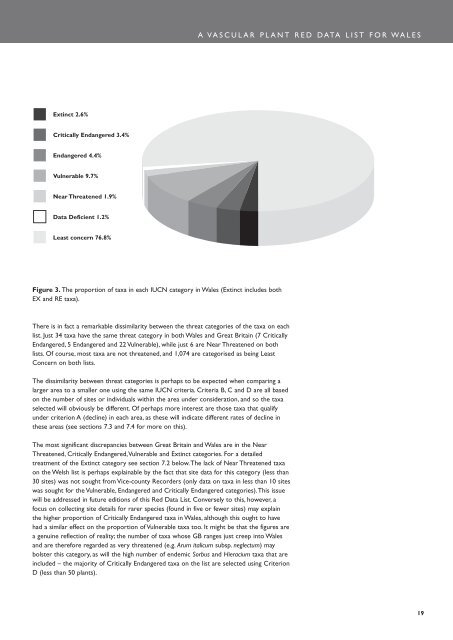A Vascular Plant Red Data List for Wales - Plantlife
A Vascular Plant Red Data List for Wales - Plantlife
A Vascular Plant Red Data List for Wales - Plantlife
Create successful ePaper yourself
Turn your PDF publications into a flip-book with our unique Google optimized e-Paper software.
A VA S C U L A R P L A N T R E D D ATA L I S T F O R WA L E SExtinct 2.6%Critically Endangered 3.4%Endangered 4.4%Vulnerable 9.7%Near Threatened 1.9%<strong>Data</strong> Deficient 1.2%Least concern 76.8%Figure 3. The proportion of taxa in each IUCN category in <strong>Wales</strong> (Extinct includes bothEX and RE taxa).There is in fact a remarkable dissimilarity between the threat categories of the taxa on eachlist. Just 34 taxa have the same threat category in both <strong>Wales</strong> and Great Britain (7 CriticallyEndangered, 5 Endangered and 22 Vulnerable), while just 6 are Near Threatened on bothlists. Of course, most taxa are not threatened, and 1,074 are categorised as being LeastConcern on both lists.The dissimilarity between threat categories is perhaps to be expected when comparing alarger area to a smaller one using the same IUCN criteria. Criteria B, C and D are all basedon the number of sites or individuals within the area under consideration, and so the taxaselected will obviously be different. Of perhaps more interest are those taxa that qualifyunder criterion A (decline) in each area, as these will indicate different rates of decline inthese areas (see sections 7.3 and 7.4 <strong>for</strong> more on this).The most significant discrepancies between Great Britain and <strong>Wales</strong> are in the NearThreatened, Critically Endangered,Vulnerable and Extinct categories. For a detailedtreatment of the Extinct category see section 7.2 below.The lack of Near Threatened taxaon the Welsh list is perhaps explainable by the fact that site data <strong>for</strong> this category (less than30 sites) was not sought from Vice-county Recorders (only data on taxa in less than 10 siteswas sought <strong>for</strong> the Vulnerable, Endangered and Critically Endangered categories).This issuewill be addressed in future editions of this <strong>Red</strong> <strong>Data</strong> <strong>List</strong>. Conversely to this, however, afocus on collecting site details <strong>for</strong> rarer species (found in five or fewer sites) may explainthe higher proportion of Critically Endangered taxa in <strong>Wales</strong>, although this ought to havehad a similar effect on the proportion of Vulnerable taxa too. It might be that the figures area genuine reflection of reality; the number of taxa whose GB ranges just creep into <strong>Wales</strong>and are there<strong>for</strong>e regarded as very threatened (e.g. Arum italicum subsp. neglectum) maybolster this category, as will the high number of endemic Sorbus and Hieracium taxa that areincluded – the majority of Critically Endangered taxa on the list are selected using CriterionD (less than 50 plants).19
















